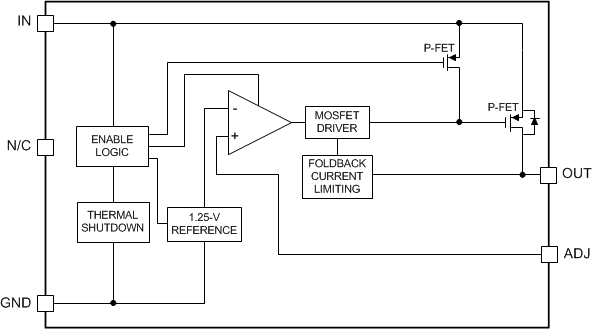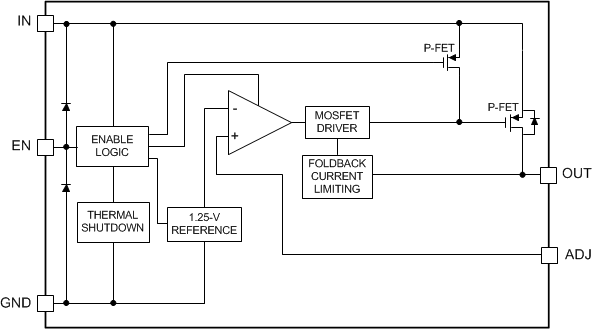SNVS324K January 2005 – January 2016 LP38691-ADJ , LP38691-ADJ-Q1 , LP38693-ADJ , LP38693-ADJ-Q1
PRODUCTION DATA.
- 1 Features
- 2 Applications
- 3 Description
- 4 Revision History
- 5 Pin Configuration and Functions
- 6 Specifications
- 7 Detailed Description
-
8 Application and Implementation
- 8.1 Application Information
- 8.2
Typical Applications
- 8.2.1 Design Requirements
- 8.2.2 Detailed Design Procedure
- 8.2.3 Application Curve
- 9 Power Supply Recommendations
- 10Layout
- 11Device and Documentation Support
- 12Mechanical, Packaging, and Orderable Information
Package Options
Mechanical Data (Package|Pins)
- NGG|6
Thermal pad, mechanical data (Package|Pins)
Orderable Information
7 Detailed Description
7.1 Overview
The LP3869x-ADJ devices are designed to meet the requirements of portable, battery-powered digital systems providing an accurate output voltage with fast start-up. When disabled via a low logic signal at the enable pin (EN), the power consumption is reduced to virtually zero (LP38693-ADJ only).
These LP3869x-ADJ devices perform well with a single 1-μF input capacitor and a single 1-μF ceramic output capacitor.
7.2 Functional Block Diagrams
 Figure 26. LP38691 Functional Diagram (WSON)
Figure 26. LP38691 Functional Diagram (WSON)
 Figure 27. LP38693 Functional Diagram (SOT-223, WSON)
Figure 27. LP38693 Functional Diagram (SOT-223, WSON)
7.3 Feature Description
7.3.1 Enable (EN)
The LP38693-ADJ has an enable pin (EN) which allows an external control signal to turn the regulator output to either an ON or OFF state. The Enable on/off threshold has no hysteresis. The voltage signal must rise and fall cleanly, and promptly, through the on and off voltage thresholds. The EN pin voltage must be higher than the VEN(MIN) threshold to ensure that the device is fully enabled under all operating conditions. The EN pin voltage must be lower than the VEN(MAX) threshold to ensure that the device is fully disabled. The EN pin has no internal pullup or pulldown to establish a default condition and, as a result, this pin must be terminated either actively or passively. If the EN pin is driven from a source that actively pulls high and low, the drive voltage should not be allowed to go below ground potential or higher than VIN. If the application does not require the enable function, the EN pin should be connected directly to the IN pin.
7.3.2 Thermal Overload Protection (TSD)
Thermal shutdown disables the output when the junction temperature rises to approximately 160°C which allows the device to cool. When the junction temperature cools to approximately 150°C, the output circuitry enables.
Based on power dissipation, thermal resistance, and ambient temperature, the thermal protection circuit may cycle on and off. This thermal cycling limits the dissipation of the regulator and protects it from damage as a result of overheating. The TSD circuitry of the LP38693 has been designed to protect against temporary thermal overload conditions.
The TSD circuitry was not intended to replace proper heat-sinking. Continuously running the LP38693 device into thermal shutdown degrades device reliability.
7.3.3 Foldback Current Limiting
Foldback current limiting is built into the LP3869x-ADJ devices which reduces the amount of output current the part can deliver as the output voltage is reduced. The amount of load current is dependent on the differential voltage between the VIN and VOUT. Typically, when this differential voltage exceeds 5 V, the load current will limit at about 350 mA. When the VIN – VOUT differential is reduced below 4 V, load current is limited to about 850 mA.
CAUTION
When toggling the LP38693 Enable (EN) after the input voltage (VIN) is applied, the foldback current limit circuitry is functional the first time that the EN pin is taken high. The foldback current limit circuitry is non-functional the second, and subsequent, times that the EN pin is taken high. Depending on the input and output capacitance values the input inrush current may be higher than expected which can cause the input voltage to droop.
If the EN pin is connected to the IN pin, the foldback current limit circuitry is functional when VIN is applied if VIN starts from less than 0.4 V.
7.4 Device Functional Modes
7.4.1 Enable (EN)
The LP38693-ADJ may be switched to the ON or OFF state by logic input at the EN pin. A logic-high voltage on the EN pin turns the device to the ON state. A logic-low voltage on the EN pin turns the device to the OFF state. If the application does not require the shutdown feature, the EN pin must be tied to VIN to keep the regulator output permanently in the ON state when power is applied.
To ensure proper operation, the signal source used to drive the EN input must be able to swing above and below the specified turnon or turnoff voltage thresholds listed in the Electrical Characteristics section under VEN.